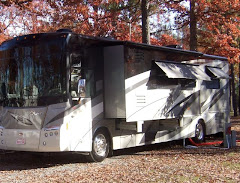
We didn't let any grass grow under our feet after arriving in Iron Mountain. We're here to visit friends Don and Judy and Mary Ellen and Len. This busy foursome is on a Habitat for Humanity build in town, and today was their day off. So, we joined them and some of their co-workers for a day of Yooper sightseeing. After fueling ourselves with a hearty breakfast in Escanaba, our first stop was Palms Book State Park, which is west of Manistique. The big attraction there is Kitch-iti-kipi. This "Big Spring" is 200-feet across and 40-feet deep with crystal clear water. This serene setting was a honeymoon stop for Mary Ellen and Len just 50 years ago. They showed us the way to the spring and the self-operated cable raft that crosses the water.
The raft gives you an up close and personal look into the depths of Kitch-iti-kipi. The center of the hull is open for viewing. Paul joined Don and Judy to take a look.
I pointed the camera into the water knowing a picture wouldn't do it justice. We had a clear shot of the bottom 40-feet below and some 10,000 gallons of water per minute gushing into the spring. It was a dramatic sight that made a very flat picture.
These ducks enjoyed their perch on the clear water in the sunshine. And, we enjoyed sharing this honeymoon spot with our friends.
From Kitch-iti-kipi, we traveled to Fayette, a historic townsite on beautiful Snail Shell Harbor on Lake Michigan's Garden Peninsula. Fayette was founded by the Jackson Iron Company after the Civil War. Nineteen community structures are being preserved by the Michigan Department of Natural Resources. Our tour guide took us on a 30-minute trip back into history.
These two blast furnaces were the centerpiece of the town and the company's operations. From 1867 to 1891 more than 230 tons of charcoal pig iron was smelted here.
The machine shop was once a center of activity. Today, it's a quiet and peaceful spot that stands near the ruins of the blacksmith shop next door.
The ruins of the old company store offer a stunning view of the harbor. As the only spot for miles to purchase goods, this place held a monopoly. Many a worker "owed their soul to the company store."
At its peak, some 500 people called Fayette home. This is the view from a laborers cabin, which has been reconstructed on site. The place was tiny, but the view of Slag Beach is lovely.
Yes, a theme developed as I snapped photos around this industrial ghost town. So, we'll just let the windows tell the story. This is the back window on one of the "middle-class" homes that still stand just steps away from the center of town.
The stately doctor's house sits up the hill in the shade. It served as both home and office for the town physician.
The company superintendent enjoyed the biggest house with the best views of the harbor and the town. His was the only home with a fenced yard, which was used to keep his horses close by.
Strolling through this park-like setting, it's easy to imagine how different this community must have been in its "heyday" filled with soot, smoke, noise and the smells of smelting. For the families who lived in this remote part of Michigan, where the winters are brutal and summers are sticky, life had to be hard. Spending a couple of hours in this peaceful yet haunting spot made us thankful that we got to enjoy it today as happy Summer tourists.


















1 comment:
Oh so nice that you enjoyed your tour of Fayette! The state park there is kinda cramped for camping, but serviceable if you want hookups. Across the peninsula is a small national forest campground called Portage Bay that we like a lot more! Tiny rough narrow road to get in there, but worth it once you get to the campground!
*~*~*~*~*~*~*~*~*~*~*~*~*~*~
Karen and Steve
(Our Blog) RVing: Small House... BIG Backyard
http://kareninthewoods-kareninthewoods.blogspot.com/
Post a Comment